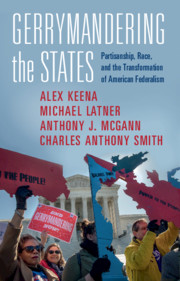Book contents
- Gerrymandering the States
- Gerrymandering the States
- Copyright page
- Contents
- Figures
- Tables
- Acknowledgments
- 1 Redistricting Wars in the US States
- 2 What Happened in 2011? The Other “Great Gerrymander”
- 3 When Politicians Draw the Maps
- 4 How Political Geography Affects Bias
- 5 Racial Geography, the Voting Rights Act, and Bias
- 6 The Policy and Social Consequences of State Legislative Gerrymandering
- 7 The Democratic Harms of Gerrymandering
- 8 When the Courts Redistrict
- 9 How to Design Effective Anti-gerrymandering Reforms
- Conclusion
- References
- Index
4 - How Political Geography Affects Bias
Published online by Cambridge University Press: 02 July 2021
- Gerrymandering the States
- Gerrymandering the States
- Copyright page
- Contents
- Figures
- Tables
- Acknowledgments
- 1 Redistricting Wars in the US States
- 2 What Happened in 2011? The Other “Great Gerrymander”
- 3 When Politicians Draw the Maps
- 4 How Political Geography Affects Bias
- 5 Racial Geography, the Voting Rights Act, and Bias
- 6 The Policy and Social Consequences of State Legislative Gerrymandering
- 7 The Democratic Harms of Gerrymandering
- 8 When the Courts Redistrict
- 9 How to Design Effective Anti-gerrymandering Reforms
- Conclusion
- References
- Index
Summary
We illuminate the role that political geography plays in determining districting outcomes. We find that the political geographic features of a state population limit the types of maps that districting authorities are able to draw. When Democrats are highly segregated – for example, in populous urban areas – it is easier for Republicans to draw very efficient gerrymanders and difficult for Democrats to draw plans that give Democrats an advantage. When we estimate the relationship between Democratic clustering in cities and Republican bias, we only see a correlation in the maps that were drawn by Republicans. This correlation does not occur in maps drawn by Democrats, or by independent actors such as courts and citizen commissions. In sum, political geography only leads to a Republican advantage when Republicans are drawing the lines. This underscores an obvious truth about redistricting: the maps do not draw themselves. Rather, humans choose the maps that best serve their personal and political interests.
- Type
- Chapter
- Information
- Gerrymandering the StatesPartisanship, Race, and the Transformation of American Federalism, pp. 79 - 95Publisher: Cambridge University PressPrint publication year: 2021



